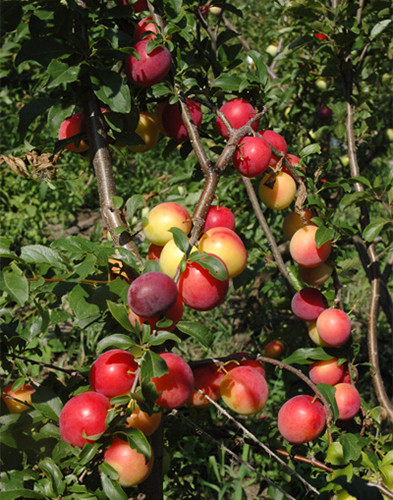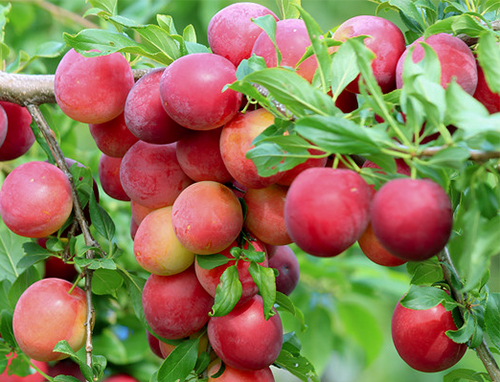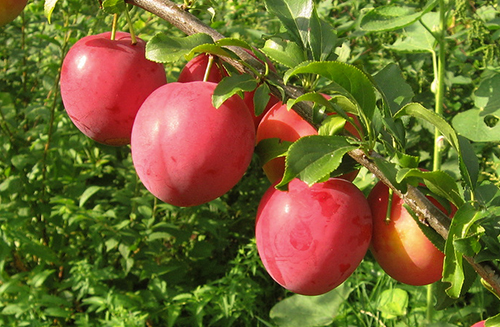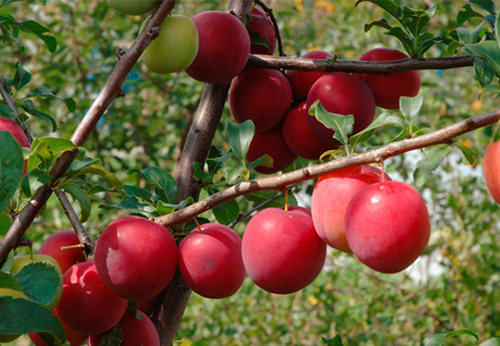Cherry plum variety Kuban comet
The Kuban comet is the most famous variety of Alycha hybrid, or Russian Plum (Prunus rossica), which ripens in the mid-early period. Bred at the Crimean Experimental Breeding Station of the All-Russian Research Institute of Plant Industry named after V.I. N.I. Vavilov through crossing the Skoroplodnaya plum variety with cherry plum Pionerka. The authorship belongs to G.V. Eremin and S.N. Zabrodina.

In 1977, the variety was sent for state testing. In 1987 entered into the State Register for the North-West (Kaliningrad Region), Central Black Earth (Belgorod, Voronezh, Kursk Region), Nizhnevolzhsky (Astrakhan, Volgograd, Saratov Region) and North Caucasian (Republics: Dagestan, Kabardino-Balkar , Adygea, North Ossetia, Ingush, Chechen, Karachay-Cherkessia; Krasnodar and Stavropol Territories, Rostov Region) regions.
The trees of this cherry plum are weak (up to 2.5 - 3 meters high), they are usually formed in the form of a shrub. The crown is flat-rounded, medium thickened. Stem with a smooth surface, not twisted, gray in color, lentils are rare. Shoots are horizontal, of medium thickness, gray in color, with a pale tan on the sunny side, few lentils. The overgrowing twigs are short. Leaves are medium in size, elliptical, direction of growth - vertical, sharp top; leaf margin slightly wavy, with serrate-crenate serration. The leaf blade is glossy, not pubescent, colored green. The location of the glands is at the base of the sheet. The leaf petioles are of medium length and thickness, non-pubescent, deep grooves, anthocyanin color, medium intensity.

Flower buds are small or medium in size, lagging behind the shoot, rounded; when unfolding, the scales are painted in a pale pink color. Inflorescences are two-flowered. The flowers are of medium size. Petals are white, small, obovate, medium corrugation. Sepals are oval, pressed against the petals. Stamens are orange in color, growing on the lower surfaces of the calyx. The pistils are located above the level of the stamens, each flower has one pistil, in rare cases, two. Pedicels are of medium thickness and length (1.3 - 1.4 cm).
Cherry plum fruits Kuban comet of large size (weighing 25 - 30 g, maximum weight - 45 g), round-ovoid, with a rounded, slightly pointed tip, asymmetric, maximum diameter closer to the base. The abdominal suture is weak, superficial, uniform along the entire length. The funnel is narrow, of medium or below medium depth. The skin is thin, dense, with a slight waxy coating. The color of the fruits at an early stage is yellow-red, then deep red and, when fully ripe, burgundy. The stalks are thick, of medium to less than medium length, firmly attached to the fruit. The bones are small or medium (4.2% of the fruit weight), practically not separating from the pulp, oval, elongated-elliptical from the side of the abdominal suture, symmetrical, with the greatest width in the middle; rough surface; pointed apex; the keel is missing; abdominal suture of medium width, tapering base, medium width, rounded; the edges of the dorsal seam are solid; the fusion of the ends of the abdominal and dorsal sutures is absent.

The pulp is yellow (reddish near the skin), medium density, fibrous consistency, rather juicy, with a medium aroma, the level of acidity and sugar content is medium. The taste of the fruit is very good, "full", sour-sweet, with an apricot flavor. The predominant use of the variety is fresh consumption, canning. Tasting assessment of fruits - over 4.6 points, juice with pulp - 4.4 points, jam and compote - 4.5 points.
Fruits are resistant to cracking, do not crumble for a long time when overripe. When removed at the beginning of staining, they ripen well and acquire the color characteristic of the variety. Stored in the refrigerator for up to 20 - 25 days. The level of transportability is good.
The biochemical content of fruits (per wet weight) is as follows: dry matter - 12%, total sugars - 7.7%, including sucrose - 3.0, monosugar - 4.7%, free acids - 1.7%, pectin substances - 0.58%, polyphenols - 0.437%, flavonols - 17.3 mg / 100 g, catechins - 95 mg / 100 g, anthocyanins - 18.8 mg / 100 g, ascorbic acid - 5.8 mg / 100 g.

The flowering of the Kuban comet is very abundant, takes place at an early date (at the end of April). Fruits ripen quite early (mid-July - early August), almost a month earlier than Renclode Altana; for example, for Volgograd this is the period from 10 to 23 July. The early maturity is very high: the trees bring the first harvest already 2 - 3 years after planting the seedlings in the garden. High yields, annual fruiting. Average yield - 10 kg / der., Maximum - 50 kg / der.
This cherry plum is highly winter-hardy (average winter hardiness in the conditions of the Moscow region), tolerates frosts down to minus 30 ° C. The level of drought resistance is average. The winter hardiness of flower buds is below average, but even in the years of strong freezing, the trees give a good harvest. Flowers tolerate spring frosts. The variety is relatively resistant to a complex of major diseases.
The variety is partially self-fertile. To prevent the fruits from growing small, it is recommended to thin them out while they are still green (the size of a cherry). For the fruits to be tasty and juicy, it is recommended to plant trees in areas well-lit by the sun.
This cherry plum is undemanding to soil conditions, is characterized by excellent regenerative abilities, as well as outstanding adaptability in various regions: from the Transcaucasus to the Non-Black Earth Region (Smolensk, Moscow, St. Petersburg), the Southern Urals (Chelyabinsk) and the south, Primorye (Vladivostok).
The main advantages of cherry plum Kuban comet include: large tasty fruits with a good presentation, abundant harvests, early maturity, winter hardiness, disease resistance, partial self-fertility.
Among the main disadvantages of the variety: the stone is poorly separated from the pulp, when the trees are overloaded with the harvest, the fruits become smaller, the fruits ripen unevenly.









In 2015, I bought a one-year-old seedling of the Kuban comet, at least that's what they said in the nursery that it was that variety. I bought it with a closed root system, in a container. Planted in August. This 2016, three fruits were set and all ripened. The taste is awesome and the size for fruits from a young tree is decent. With the description given here, in terms of early maturity, everything coincides. Apparently, when selling with a variety, they did not deceive, but then we'll see.
I like Russian plum much more than simple plum. The Kuban comet ripens in my climate very, very early, but at the same time the size of the fruits is good - the plums are large, the taste is simply amazing, with obvious fruity notes, the pulp is “not liquid”, but pleasant jelly-like, but juicy, and what is important - in the plum there is a very small graceful stone. This cherry plum hibernates well, but in winters with little snow there are attacks, and if there are long winter thaws, the place of grafting underpins, so the cherry plum grows better in our country “on its roots”. It blooms profusely, and even if it falls under return frosts, there are enough preserved flowers for a normal harvest.
The Kuban comet has been growing in my area for probably ten years. At the moment, this is a full-fledged and fruitful tree and in recent years it has regularly made me happy with its harvest.Ripe fruits are large, juicy, with a unique sweet and sour taste. In season, it is very pleasant to eat these wonderful berries, and what remains, I close in jars in the form of a compote. Actually, for the sake of compotes, I planted cherry plum for myself, I really like to open a jar in winter and drink a fragrant drink.
In general, cherry plum is quite unpretentious and grows well. The only thing I worry about is the early flowering in April, sometimes at this time there are still recurrent cold weather. But she seems to tolerate them easily, she has not yet observed freezing of the color.
Delicious cherry plum. I have this tree on the second site for about 5 years. It is imperative to cover for the winter, because in our area there are frosts on the ground without snow. One winter my cherry plum got very cold. She was ill almost all summer. Resistant to various diseases, but every spring it is necessary to process it with iron vitriol to prevent the appearance of fungi and moss. For better growth in the spring, for the winter I pour two buckets of water under the tree, thereby the roots are saturated with moisture, and in the spring they use it for the initial formation of buds. When flowering, it is necessary to treat the moth - this pest is very fond of such trees.